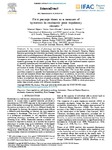Mostrar o rexistro simple do ítem
First passage times as a measure of hysteresis in stochastic gene regulatory circuits
| dc.contributor.author | Pájaro Diéguez, Manuel | |
| dc.contributor.author | Otero-Muras, Irene | |
| dc.contributor.author | Alonso, Antonio A. | |
| dc.date.accessioned | 2023-01-05T12:11:46Z | |
| dc.date.available | 2023-01-05T12:11:46Z | |
| dc.date.issued | 2022 | |
| dc.identifier.citation | M. Pájaro, I. Otero-Muras and A. A. Alonso, "First passage times as a measure of hysteresis in stochastic gene regulatory circuits," IFAC-PapersOnLine, vol. 55, (18), pp. 50-55, 2022. DOI: 10.1016/j.ifacol.2022.08.029. | es_ES |
| dc.identifier.uri | http://hdl.handle.net/2183/32301 | |
| dc.description | GAIN Oportunius Grant from Xunta de Galicia. | es_ES |
| dc.description.abstract | [Abstract]: In the context of phenotype switching and cell fate determination, numerousexperimental studies report hysteresis, despite the fact that the (forward) Chemical Master Equation governing the inherently stochastic underlying gene regulatory networks has a unique steady state (precluding memory effects and hysteresis). In previous works, we demonstrate thathysteresis is a transient phenomenon in systems far from the thermodynamic limit, using the convergence rates of the partial integro-differential equation associated to the forward master equation governing the stochastic process. Here, we make use of the backward master equationto quantify hysteresis and irreversibility based on First Passage Times. First, we derive the backward master equation for a gene regulatory network with protein production in bursts. Solving this equation, we obtain the probability distributions of the first times to reach some fixed final state from one starting state. The mean first passage time provides a measure to quantify how hysteresis and irreversibility in gene regulation at the singlecell level are transient effects that vanish at steady state. In addition, we provide a theoretical basis that reconciles phenotype coexistence and prevalence far from the thermodynamic limit. In fact, we substitute the notion of pseudo-potential (the so-called Waddington landscape) by a time evolving landscape built upon the Chemical Master Equation (CME) in which phenotypes,rather than prevail, persist with different intensities. | es_ES |
| dc.description.sponsorship | Ministerio de Ciencia e Innovación/Agencia Estatal de Investigación; FJC2019-041397-I | es_ES |
| dc.language.iso | eng | es_ES |
| dc.publisher | Elsevier | es_ES |
| dc.relation.uri | https://doi.org/10.1016/j.ifacol.2022.08.029 | es_ES |
| dc.rights | Atribución-NoComercial-SinDerivadas 4.0 Internacional (CC BY-NC-ND 4.0) | es_ES |
| dc.rights.uri | http://creativecommons.org/licenses/by-nc-nd/3.0/es/ | * |
| dc.subject | Gene regulation | es_ES |
| dc.subject | cell decision-making | es_ES |
| dc.subject | hysteresis | es_ES |
| dc.subject | Chemical Master Equation | es_ES |
| dc.subject | stochastic dynamics | es_ES |
| dc.subject | bistability | es_ES |
| dc.subject | First Passage Times | es_ES |
| dc.title | First passage times as a measure of hysteresis in stochastic gene regulatory circuits | es_ES |
| dc.type | info:eu-repo/semantics/conferenceObject | es_ES |
| dc.rights.access | info:eu-repo/semantics/openAccess | es_ES |
| UDC.journalTitle | IFAC PapersOnLine | es_ES |
| UDC.volume | 55 | es_ES |
| UDC.issue | 18 | es_ES |
| UDC.startPage | 50 | es_ES |
| UDC.endPage | 55 | es_ES |
| dc.identifier.doi | 10.1016/j.ifacol.2022.08.029 | |
| UDC.conferenceTitle | IFAC Workshop on Thermodynamics Foundations of Mathematical Systems Theory TFMST (4º. 2022. Montreal, Canadá) | es_ES |






